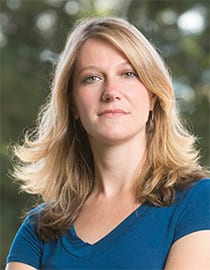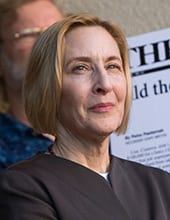By Andrew Cohen

Given the family atmosphere within Berkeley Law’s Death Penalty Clinic, there should be little surprise in seeing family dynamics fuel its mission and expand its capacity.
A major gift and matching challenge by Ken Stevens, father of clinic alum Jen Stevens ’12, will fund this year’s clinical supervising attorney position held by Kathryn Miller ’07. If the clinic receives $25,000 in donations by June 30, 2019, Stevens will add that amount to his initial contribution.
“I have no legal background whatsoever, and I didn’t even watch Law and Order,” he says. “But Jen’s involvement in the clinic during her final year of law school was transformative for her. When she told me the clinic needed support, she made clear how important its work was and how the two people who run it are incredible.”
That Berkeley Law faculty duo, Director Elisabeth Semel and Associate Director Ty Alper, rely heavily on the work that Stevens’ generosity makes possible. All of Berkeley Law’s in-house clinics were established with private donations.
“We depend upon contributions, from individuals and law firms, and foundation grants to sustain our clinic’s mission of preparing students for practice and providing high-quality representation to clients who would otherwise be without counsel,” Semel says. “Our alumni and their families have been loyal supporters. The Stevens family’s generosity has been vital to the longevity and strength of the clinic’s fellowship program.”
This school year, Miller will teach and oversee seven students who will represent three capital clients. As a clinic graduate herself, she finds it especially meaningful to train and guide those who occupy a role that shaped the trajectory of her legal career.

Miller says gifts like Stevens’ allow the clinic to “supervise more students, serve more clients, and produce litigation of the highest quality. They enable my students to travel to their client’s home state to interview witnesses in support of that client’s legal claims. They also permit the clinic to retain forensic, mental health, and neurological experts, whose evaluations and opinions provide critical support for these claims.”
A memorable experience
Clinic students gather life-history documents, interview witnesses, and collaborate with experienced capital investigators and forensic experts. They investigate facts, conduct legal research, and draft pleadings in courts in California and several southern states.
Now a partner at a small criminal defense practice in Oakland, Jen Stevens calls her time at the clinic “amazing.” Under Alper’s supervision, she worked on a case that was granted certiorari by the Alabama Supreme Court, and made multiple trips to the state to conduct interviews and help prepare witnesses.
“The clinic was my most valuable academic experience in law school,” she says. “I knew I wanted to become a defense attorney, and the clinic improved my legal skills immensely while also helping people in dire need of legal help. It taught me how to be a lawyer in a truly concrete way.”
Like her father, Stevens also supports the clinic. “There aren’t many places you can support that do these two great things at the same time: representing people at a very high level of skill on death row, and supporting a public university’s teaching mission,” she says.
Stevens’ many civic endeavors include funneling that mission to younger students at Berkeley’s Rosa Parks Elementary School. She helps Alper oversee the school’s semester-long 5th grade mock trial program that culminates with mock trials at Berkeley Law.
For Ken Stevens, supporting the Death Penalty Clinic signals faith in his daughter’s judgment and in the faculty members who helped pave her professional path.
“Given how many people are wrongfully put to death and how many death-row inmates receive bad representation, there’s great real-world benefit to this clinic in addition to the top-rate training it provides,” he says. “I’m blown away by Lis and Ty in terms of their tenacity and expertise, and the dedication they bring to their clients and students.”